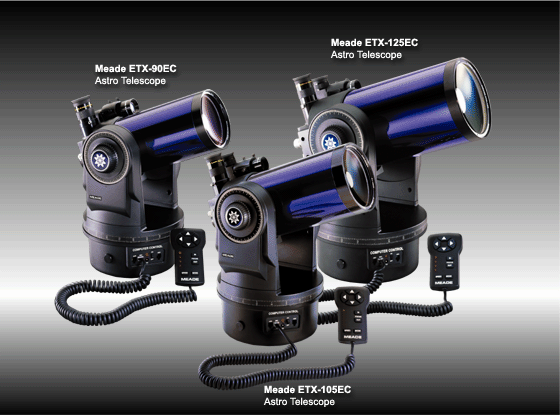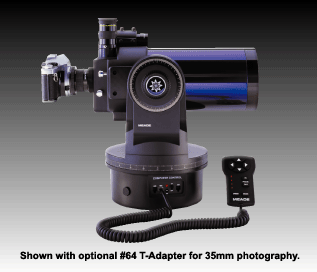
![]()
ETX Astro Telescopes
|
|
| ETX-90EC, ETX-105EC, and ETX-125EC Astro Telescopes |
 |
| When the original ETX ® telescope was introduced in 1996, it quickly created a revolution in amateur astronomy. Here for the first time was a stunningly beautiful, ultraportable, and highly versatile telescope system of unprecedented optical resolution and performance. Within one year of its introduction the ETX became the largest-selling modern telescope in the world. Meade ETX-90EC, ETX-105EC, and ETX-125EC models build on the original ETX concept to create the most advanced electronically-controlled telescopes — including optional automatic GO TO object-location with the Autostar ™ Computer Controller — ever produced in their price range. And yet without sacrificing any of the user-friendly features that started the ETX revolution. |
| Optical
Systems: Manufactured entirely at the Meade Irvine, California,
facility, ETX Maksutov-Cassegrain telescopes produce optical performance
and resolution that equal or exceed any Maksutov optics of similar
apertures ever manufactured at any price, past or present. Optics so
high in contrast, image brightness, and resolution that ETX-90EC,
ETX-105EC, and ETX-125EC models often out-perform many telescopes of
larger apertures.
Fork Mounts with Standard-Equipment Dual-Axis Drive System and Electronic Controller: The fork mountings of ETX Maksutov-Cassegrain models include high-torque DC motors on both telescope axes, permitting electronic operation from the standard-equipment plug-in hand controller. Use the pushbutton electronic controller at any of four dual-axis speeds: 8x sidereal for image centering in the main telescope at high power; 32x for image centering at lower powers or for pushbutton object-tracking in the altazimuth mode; 0.75°/second for image centering in the viewfinder or for terrestrial tracking; 5°/second for fast slewing across the sky. The observer can instantly select any of these speeds simply by depressing the SPEED button on the controller. Altazimuth or Equatorial Operation: With the telescope placed in the altazimuth mode on a table, astronomical object-tracking may be accomplished from the directional pushbuttons of the hand controller. Fully automatic astronomical tracking in the altazimuth mode may be accomplished with the optional Autostar Computer Controller. Alternately, any ETX telescope may be mounted in the equatorial orientation, using either an optional Table Tripod or the Deluxe Field Tripod. In this latter case the telescope tracks celestial objects automatically at the sidereal rate. Cordless Field Operation: The drive base of each telescope accepts eight (user-supplied) AA-batteries that power the telescope for more than 40 hours of normal usage, negating any requirement for an external power source in the field. Alternately, the telescope may be powered from an automobile cigarette lighter plug, using the optional #607 Power Cord. Flip-Mirror System: Flip the internal, optical-flat mirror "up" for observing in the standard 90° position; flip the mirror "down" for terrestrial observing with the optional #932 45° Erecting Prism or for photography with the optional #64 T-Adapter. Materials and Coatings: ETX optical systems include a Maksutov meniscus corrector lens of Grade-A BK7 optical glass. This lens is individually hand-figured by a Meade master optician to achieve an optical null in combination with the Pyrex primary mirror. High transmission magnesium fluoride (MgF2) coatings on both sides of the correcting lens, as well as aluminum/silicon monoxide coatings on the primary and secondary mirrors, are provided as standard equipment. Ultra-High Transmission Coatings (UHTC): Available optionally with the ETX-90EC, ETX-105EC, or ETX-125EC, the Meade UHTC group permits the highest levels of light transmission (a 20% increase in total telescope light trans-mission compared to the standard-equipment coatings) ever offered on amateur telescopes. The UHTC group, if desired, must be specified at the time of telescope order. Standard Equipment: Meade ETX Astro Telescopes are supplied as
complete instruments. Standard equipment includes a premium-grade Meade
Series 4000 Super Plössl 26mm eyepiece for 48X with the ETX-90EC, 57X
with the ETX-105EC, or 73X with the ETX-125EC. The 8 x 21mm viewfinder
of the ETX-90EC incorporates an internal roof prism that results in an
erect-image orientation, facilitating the quick location and
field-centering of both terrestrial and astronomical objects. ETX-105EC
and ETX-125EC models are supplied with an 8 x 25mm right-angle
viewfinder for comfortable object-sighting with the larger instruments.
Optional Accessories: Over 20 optionally available eyepieces permit magnification ranges of from 31X to over 300X with the ETX-90EC, from 37X to over 400X with the ETX-105EC, or from 48X to over 450X with the ETX-125EC. Meade Super Plössls are excellent eyepieces with any ETX model, or use a Meade Super Wide 13.8mm, 18mm, or 24.5mm ocular for spectacular moderate-power, wide-angle observing. The #126 2x Barlow Lens, a special short-focus Barlow ideally suited to ETX systems, doubles the power of any eyepiece. For terrestrial photography or astrophotography of the Moon and planets, the #64 T-Adapter threads to the telescope's rear cell and, with the appropriate T-mount, accepts any 35mm camera with removable lens. "I find it impossible to choose adequate words that describe the extraordinary performance of the ETX [90mm]. My first object was the waxing gibbous Moon. At 50X the image showed incredible contrast and sharpness along the terminator. It begged for higher magnifications. At 190X the lunar image fully maintained its rock-hard focus. Even at 350X, one hundred power per inch of aperture, no breakdown of the image occurred. Now I had to give the ETX the most sensitive test of all, viewing a second magnitude star at this same extreme power. The 350X star image was a textbook classic. Clearly defined, faint, concentric diffraction rings surrounded the small, bright Airy disc. Taking the star both in and out of focus revealed identically sized secondary shadow obstructions. Clearly, I was observing through an optical system that has no detectable wavefront error." — Ron Smith, Professor of Astronomy, Santa Rosa Junior College, Santa Rosa, California. 
Optional #497 Autostar Computer Controller: One of the most important advances in telescope design in the past 25 years, the Autostar Computer Controller brings to the amateur astronomer features heretofore available only on much more expensive telescopes. With the #497 Autostar plugged into your ETX, finding any of more than 30,000 celestial objects stored in the Autostar database is as easy as pushing a button. Call up any database object, press GO TO, and watch as the telescope automatically moves to the object and places it in the telescopic field of view. Click for complete details on the full range of Autostar capabilities. "Stellar diffraction patterns were virtually textbook-perfect... the Cassini Division in Saturn's rings popped into view despite the rings' low tilt. [Double-star] Epsilon Lyrae's component stars were cleanly split... The Moon was outstanding even at 75X per inch of aperture. Daytime terrestrial views were tack-sharp with rich color saturation. I could see every wisp of velvet on the antlers of a deer 50 feet away... the ETX [90mm] was totally free of chromatic aberration, making this an ideal all-purpose telescope for anyone wanting to inspect eagles at 100 yards and stars at 100 light-years." — from the review in Sky & Telescope, January 1997.
|
  Specifications: ETX-90EC Astro Telescope — Includes Maksutov-Cassegrain optical tube assembly (D = 90mm (3.5"), F = 1250mm, f/13.8) with MgF2 coatings on the correcting lens and standard aluminum coatings on the primary and secondary mirrors (Ultra-High Transmission Coatings, available optionally); internal flip-mirror system for either straight-through or 90° observing position; steel-reinforced ABS fork mount with electric slow-motion controls, setting circles and locks on both axes; electronic control panel; 4-speed (8x, 32x, 0.75°/sec, 5°/sec) dual-axis motor drive system with Electronic Controller; sidereal-rate tracking in equatorial mode with optional table tripod or deluxe field tripod; internal battery compartment accepting eight (user-supplied) AA-size batteries; 8x21mm erect-image viewfinder; Series 4000 Super Plössl 26mm eyepiece (1.25"); operating instructions.
ETX-90EC Astro Telescope: For the casual or beginning observer the Meade ETX-90EC may be all the telescope ever required. Or, for the advanced astronomer who already owns a larger instrument, the ETX-90EC is the perfect ultraportable, diffraction-limited field telescope. Observe the continually changing cloud-belt patterns on the surface of the planet Jupiter; shadows cast on to Jupiter as one of its four principal satellites transits the planet's disc; the magnificent ring system and satellites of Saturn as well as dusky markings and the ring-shadow on the surface of Saturn; Moon craters by the hundred, plus lunar rilles, mountain ranges, and fault lines, all visible in brilliant, high-resolution, high-contrast detail; the variable phases of the planets Mercury and Venus; prominent features on the surface of Mars. In deep-space the motivated observer will find it difficult to exhaust the quantity of visible phenomena: the incandescent filamentary structure of the Orion Nebula; the elliptical luminosity of the Andromeda Galaxy with its brilliant nucleus; the shining orb of the Hercules globular cluster with many of its outermost stars resolvable. These are only a few of the literally thousands of celestial objects within the view of the Meade ETX-90EC telescope. Star catalogs list innumerable double and multiple star systems, variable stars, open star clusters, globular clusters, diffuse nebulosities, planetary nebulae, and spiral galaxies within the grasp of the instrument. The optional Autostar Computer Controller can locate all of these objects automatically, in seconds.  ETX-105EC Astro Telescope: Manufactured with an aluminum fork mount dedicated specifically to its size and aperture, the ETX-105EC Astro Telescope moves effortlessly across the skies on ball bearing axes, in either manual or electronic modes. And, at a relatively modest increase in purchase price, the ETX-105EC yields 36% more light-collecting power than the ETX-90EC. The entire range of celestial objects — the eight major planets, the Moon, galaxies, nebulae, star clusters — as well as terrestrial objects, may be observed with a significant, and immediately apparent, increase in resolution and image brightness. At the same time, the ETX-105EC maintains most of the compactness and ultraportability of the smaller-aperture ETX-90EC. As a compromise between the larger light-gathering capability of the ETX-125EC and the ultraportability of the ETX-90EC, the ETX-105EC is an excellent, and very popular, choice. 
ETX-125EC Astro Telescope: With twice the light-collecting area of the ETX-90EC, the ETX-125EC permits a much broader range of astronomical study. Jupiter's cloud belts, for example, are observable at a significantly heightened level of detail, with whirls and festoons and the Great Red Spot readily visible as they transit the planet's disc; the Cassini division in Saturn's rings is routinely seen, as are additional features of the planet's surface, even under less than perfect seeing conditions; microfine lunar detail beyond the reach of smaller telescopes can be resolved in the ETX-125EC. In deep-space the ETX-125EC's larger aperture enables the observation of galaxies and nebulae in much wider extension and permits the resolution of celestial objects as faint as magnitude 12.5. The entire Messier listing of 110 objects is now not only visible, but, in addition, every object takes on a readily discernible structure. The observer who accepts astronomy as a serious field of interest will find the Meade ETX-125EC a deeply satisfying instrument for a lifetime of high-resolution astronomical study. More information about ETX-Series Telescopes is available below:
**Autostar Update Software is a free download that allows the Autostar operating system and object catalogs to be updated over the Internet (e.g. to input new comets, asteroids, and tours). The #497 Autostar requires the #505 Connector Cable Kit to allow updates. |
| ALL
Telescopes are for U.S.A. sales ONLY. Please contact your international representative for dealers in your area. |
|
| 1-800-701-STAR (7827) or Order Online | |